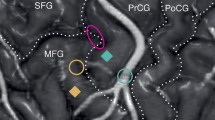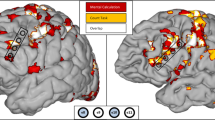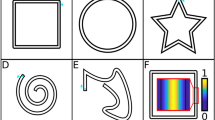Abstract
Intracortical brain–machine interfaces decode motor commands from neural signals and translate them into actions, enabling movement for paralysed individuals. The subjective sense of agency associated with actions generated via intracortical brain–machine interfaces, the neural mechanisms involved and its clinical relevance are currently unknown. By experimentally manipulating the coherence between decoded motor commands and sensory feedback in a tetraplegic individual using a brain–machine interface, we provide evidence that primary motor cortex processes sensory feedback, sensorimotor conflicts and subjective states of actions generated via the brain–machine interface. Neural signals processing the sense of agency affected the proficiency of the brain–machine interface, underlining the clinical potential of the present approach. These findings show that primary motor cortex encodes information related to action and sensing, but also sensorimotor and subjective agency signals, which in turn are relevant for clinical applications of brain–machine interfaces.
This is a preview of subscription content, access via your institution
Access options
Access Nature and 54 other Nature Portfolio journals
Get Nature+, our best-value online-access subscription
$29.99 / 30 days
cancel any time
Subscribe to this journal
Receive 12 digital issues and online access to articles
$119.00 per year
only $9.92 per issue
Buy this article
- Purchase on Springer Link
- Instant access to full article PDF
Prices may be subject to local taxes which are calculated during checkout






Similar content being viewed by others
Data availability
Behavioural data and processed data necessary to reproduce the figures in the main text can be found in the OSF repository accessible at: https://osf.io/7rma5/?view_only=9928bd8e32a748828f7ecfdbeb1f8baa.
Neural data and code for BMI control can be made available to qualified individuals for collaboration via a written agreement between Battelle Memorial Institute and the requester’s affiliated institution. Such enquiries or requests should be directed to: ganzer@battelle.org.
Code availability
Custom code for neural data analysis and BMI control can be obtained following a written agreement between Battelle Memorial Institute and the requester’s affiliated institution. Such inquiries or requests should be directed to: ganzer@battelle.org. Inquiries or requests concerning custom analysis code used for this study should be directed to A.S.
References
Blakemore, S. J., Wolpert, D. M. & Frith, C. D. Abnormalities in the awareness of action. Trends Cogn. Sci. 6, 237–242 (2002).
Jeannerod, M. Motor Cognition: What Actions Tell the Self (Oxford Univ. Press, 2006).
Haggard, P. Sense of agency in the human brain. Nat. Rev. Neurosci. 18, 196–207 (2017).
Hochberg, L. R. et al. Reach and grasp by people with tetraplegia using a neurally controlled robotic arm. Nature 485, 372–375 (2012).
Collinger, J. L. et al. High-performance neuroprosthetic control by an individual with tetraplegia. Lancet 381, 557–564 (2013).
Bouton, C. E. et al. Restoring cortical control of functional movement in a human with quadriplegia. Nature 533, 247–250 (2016).
Ajiboye, A. B. et al. Restoration of reaching and grasping movements through brain-controlled muscle stimulation in a person with tetraplegia: a proof-of-concept demonstration. Lancet 389, 1821–1830 (2017).
Lebedev, M. A. & Nicolelis, M. A. L. Brain–machine interfaces: from basic science to neuroprostheses and neurorehabilitation. Physiol. Rev. 97, 767–837 (2017).
Donoghue, J. P. Connecting cortex to machines: recent advances in brain interfaces. Nat. Neurosci. 5, 1085–1088 (2002).
Nierula, B. et al. Agency and responsibility over virtual movements controlled through different paradigms of brain−computer interface. J. Physiol. 0, 1–16 (2019).
Nierula, B. & Sanchez-Vives, M. V. in Brain-Computer Interface Research (eds Guger, C., Mrachacz-Kersting, N. & Allison, B.) (Springer, 2019).
Sato, A. & Yasuda, A. Illusion of sense of self-agency: discrepancy between the predicted and actual sensory consequences of actions modulates the sense of self-agency, but not the sense of self-ownership. Cognition 94, 241–255 (2005).
Marchesotti, S. et al. Cortical and subcortical mechanisms of brain-machine interfaces. Hum. Brain Mapp. 38, 2971–2989 (2017).
Evans, N., Gale, S., Schurger, A. & Blanke, O. Visual feedback dominates the sense of agency for brain–machine actions. PLoS ONE 10, e0130019 (2015).
Knoblich, G. & Sebanz, N. Agency in the face of error. Trends Cogn. Sci. 9, 259–261 (2005).
Tsakiris, M., Prabhu, G. & Haggard, P. Having a body versus moving your body: how agency structures body-ownership. Conscious. Cogn. 15, 423–432 (2006).
Scott, S. H., Cluff, T., Lowrey, C. R. & Takei, T. Feedback control during voluntary motor actions. Curr. Opin. Neurobiol. 33, 85–94 (2015).
Shokur, S. et al. Expanding the primate body schema in sensorimotor cortex by virtual touches of an avatar. Proc. Natl Acad. Sci. USA 110, 15121–15126 (2013).
Hatsopoulos, N. G. & Suminski, A. J. Sensing with the motor cortex. Neuron 72, 477–487 (2011).
Hatsopoulos, N. G., Xu, Q. & Amit, Y. Encoding of movement fragments in the motor cortex. J. Neurosci. 27, 5105–5114 (2007).
Suminski, A. J., Tkach, D. C., Fagg, A. H. & Hatsopoulos, N. G. Incorporating feedback from multiple sensory modalities enhances brain–machine interface control. J. Neurosci. 30, 16777–16787 (2010).
Tkach, D., Reimer, J. & Hatsopoulos, N. G. Congruent activity during action and action observation in motor cortex. J. Neurosci. 27, 13241–13250 (2007).
Churchland, M. M. & Shenoy, K. V. Temporal complexity and heterogeneity of single-neuron activity in premotor and motor cortex. J. Neurophysiol. 97, 4235–4257 (2007).
Schwartz, A. B. Movement: how the brain communicates with the world. Cell 164, 1122–1135 (2016).
O’Doherty, J. E. et al. Active tactile exploration using a brain–machine–brain interface. Nature 479, 228–231 (2011).
Stepniewska, I., Preuss, T. M. & Kaas, J. H. Architectionis, somatotopic organization, and ipsilateral cortical connections of the primary motor area (M1) of owl monkeys. J. Comp. Neurol. 330, 238–271 (1993).
Eickhoff, S. B. et al. Anatomical and functional connectivity of cytoarchitectonic areas within the human parietal operculum. J. Neurosci. 30, 6409–6421 (2010).
Fetz, E. E., Finocchio, D. V., Baker, M. A. & Soso, M. J. Sensory and motor responses of precentral cortex cells during comparable passive and active joint movements. J. Neurophysiol. 43, 1070–1089 (1980).
Hochberg, L. R. et al. Neuronal ensemble control of prosthetic devices by a human with tetraplegia. Nature 442, 164–171 (2006).
Tabot, G. A. et al. Restoring the sense of touch with a prosthetic hand through a brain interface. Proc. Natl Acad. Sci. USA 110, 18279–18284 (2013).
Flesher, S. N. et al. Intracortical microstimulation of human somatosensory cortex. Sci. Transl. Med. 8, 361ra141 (2016).
Bensmaia, S. J. & Miller, L. E. Restoring sensorimotor function through intracortical interfaces: progress and looming challenges. Nat. Rev. Neurosci. 15, 313–325 (2014).
Desmurget, M. et al. Movement intention after parietal cortex stimulation in humans. Science 324, 811–813 (2009).
Farrer, C. & Frith, C. D. Experiencing oneself vs another person as being the cause of an action: the neural correlates of the experience of agency. Neuroimage 15, 596–603 (2002).
Chambon, V., Wenke, D., Fleming, S. M., Prinz, W. & Haggard, P. An online neural substrate for sense of agency. Cereb. Cortex 23, 1031–1037 (2013).
Fried, I., Mukamel, R. & Kreiman, G. Internally generated preactivation of single neurons in human medial frontal cortex predicts volition. Neuron 69, 548–562 (2011).
Fornia, L. et al. Direct electrical stimulation of the premotor cortex shuts down awareness of voluntary actions. Nat. Commun. 11, 1–11 (2020).
Sperduti, M., Delaveau, P., Fossati, P. & Nadel, J. Different brain structures related to self- and external-agency attribution: a brief review and meta-analysis. Brain Struct. Funct. 216, 151–157 (2011).
Blanke, O., Slater, M. & Serino, A. Behavioral, neural, and computational principles of bodily self-consciousness. Neuron 88, 145–166 (2015).
Makin, T. R., Holmes, N. P. & Ehrsson, H. H. On the other hand: dummy hands and peripersonal space. Behav. Brain Res. 191, 1–10 (2008).
Rognini, G. et al. Multisensory bionic limb to achieve prosthesis embodiment and reduce distorted phantom limb perceptions. J. Neurol. Neurosurg. Psychiatry 90, 833–836 (2019).
Sanchez-Vives, M. V., Spanlang, B., Frisoli, A., Bergamasco, M. & Slater, M. Virtual hand illusion induced by visuomotor correlations. PLoS ONE 5, e10381 (2010).
Yuste, R. et al. Four ethical priorities for neurotechnologies and AI. Nature 551, 159–163 (2017).
Fried, I., Haggard, P., He, B. J. & Schurger, A. Volition and action in the human brain: processes, pathologies, and reasons. J. Neurosci. 37, 10842–10847 (2017).
Goering, S. et al. Recommendations for responsible development and application of neurotechnologies. Neuroethics 29, 1–22 (2021).
Blanke, O. & Aspell, J. E. Brain technologies raise unprecedented ethical challenges. Nature 458, 703 (2009).
Wang, W. et al. Specific brain morphometric changes in spinal cord injury: a voxel-based meta-analysis of white and gray matter volume. J. Neurotrauma 36, 2348–2357 (2019).
Melo, M. C., Macedo, D. R. & Soares, A. B. Divergent findings in brain reorganization after spinal cord injury: a review. J. Neuroimag. 30, 410–427 (2020).
Freund, P. et al. MRI investigation of the sensorimotor cortex and the corticospinal tract after acute spinal cord injury: a prospective longitudinal study. Lancet Neurol. 12, 873–881 (2013).
Henderson, L. A., Gustin, S. M., Macey, P. M., Wrigley, P. J. & Siddall, P. J. Functional reorganization of the brain in humans following spinal cord injury: evidence for underlying changes in cortical anatomy. J. Neurosci. 31, 2630–2637 (2011).
Mallat, S. A Wavelet Tour of Signal Processing: The Sparce Way 3rd edn (Elsevier, 2009).
Humber, C., Ito, K. & Bouton, C. Nonsmooth formulation of the support vector machine for a neural decoding problem. Preprint at https://arxiv.org/abs/1012.0958 (2010).
Colachis IV, S. C. et al. Dexterous control of seven functional hand movements using cortically-controlled transcutaneous muscle stimulation in a person with tetraplegia. Front. Neurosci. 12, 1–14 (2018).
Colachis IV, S. C. Optimizing the Brain-Computer Interface for Spinal Cord Injury Rehabilitation. MSc thesis, Ohio State Univ. (2018).
Zhang, M. et al. Extracting wavelet based neural features from human intracortical recordings for neuroprosthetics applications. Bioelectron. Med. 4, 11 (2018).
Quiroga, R. Q., Nadasdy, Z. & Ben-Shaul, Y. Unsupervised spike detection and sorting with wavelets and superparamagnetic clustering. Neural Comput. 16, 1661–1687 (2004).
Hoerl, A. E. & Kennard, R. W. Ridge regression: biased estimation for nonorthogonal problems. Technometrics 12, 55–67 (1970).
Kuhn, M. caret: Classification and regression training. R package version 6.0-80 https://cran.r-project.org/web/packages/caret (2018).
Maris, E. & Oostenveld, R. Nonparametric statistical testing of EEG- and MEG-data. J. Neurosci. Methods 164, 177–190 (2007).
Acknowledgements
The authors thank I. Burkhart for his dedication to the study and insightful conversations. A.S. is supported by the Swiss National Science Foundation (grant no. PP00P3_163951/1). M.B. is supported by the Craig H. Neilsen Foundation (grant no. 651289) and State of Ohio Research Incentive Third Frontier Fund. N.F. received funding from the European Research Council under the European Union Horizon 2020 research and innovation programme (grant no. 803122). O.B. is supported by two donors advised by CARIGEST SA (Fondazione Teofilo Rossi di Montelera e di Premuda and a second one wishing to remain anonymous), by the National Center of Competence in Research ‘Synapsy—The Synaptic Bases of Mental Diseases’ (grant no. 51NF40-185897), by the Swiss National Science Foundation (grant no. 320030-188798), by Parkinson Suisse and by the Empiris Foundation. The funders had no role in study design, data collection and analysis, decision to publish or preparation of the manuscript.
Author information
Authors and Affiliations
Contributions
A.S.: conceptualization, formal analysis, methodology, writing; M.B.: methodology, investigation, project administration, review and editing; T.B.: data curation, formal analysis, software, visualization, review and editing; S.C.: methodology, data curation, formal analysis, investigation, software; M.S.: formal analysis, investigation, visualization, review and editing; C.D. and K.E.: investigation, data collection; P.G.: methodology, review and editing; G.S.: methodology, software and hardware development; N.A.: methodology, review and editing; P.O.: investigation, software and hardware development; D.F.: investigation, software and hardware development; P.S.: methodology, review and editing; N.F.: formal analysis, methodology, visualization, review and editing; A.R.: funding acquisition, resources, supervision, review and editing; O.B.: conceptualization, funding acquisition, methodology, supervision and writing.
Corresponding authors
Ethics declarations
Competing interests
A.S. is head of Neuroscience at MindMaze SA. O.B. is cofounder and shareholder of Metaphysiks Engineering SA, as well as member of the board and shareholder of MindMaze SA. P.G., G.S., N.A. and D.F. hold patents for the BMI system. M.B, C.D., K.E., M.S., T.B., N.F., P.S. and A.R. declare no competing interests.
Additional information
Peer review information Nature Human Behaviour thanks the anonymous reviewers for their contribution to the peer review of this work.
Publisher’s note Springer Nature remains neutral with regard to jurisdictional claims in published maps and institutional affiliations. Peer reviewer reports are available.
Supplementary information
Supplementary information
Supplementary text, Figs. 1–6 and Table 1.
Rights and permissions
About this article
Cite this article
Serino, A., Bockbrader, M., Bertoni, T. et al. Sense of agency for intracortical brain–machine interfaces. Nat Hum Behav 6, 565–578 (2022). https://doi.org/10.1038/s41562-021-01233-2
Received:
Accepted:
Published:
Issue Date:
DOI: https://doi.org/10.1038/s41562-021-01233-2
This article is cited by
-
A novel theta-controlled vibrotactile brain–computer interface to treat chronic pain: a pilot study
Scientific Reports (2024)
-
Sensory integration for neuroprostheses: from functional benefits to neural correlates
Medical & Biological Engineering & Computing (2024)
-
Optimization Driven Spike Deep Belief Neural Network classifier: a deep-learning based Multichannel Spike Sorting Neural Signal Processor (NSP) module for high-channel-count Brain Machine Interfaces (BMIs)
Artificial Intelligence Review (2023)
-
Synchronous motor imagery and visual feedback of finger movement elicit the moving rubber hand illusion, at least in illusion-susceptible individuals
Experimental Brain Research (2023)
-
Multisensory Integration in Bionics: Relevance and Perspectives
Current Physical Medicine and Rehabilitation Reports (2022)



